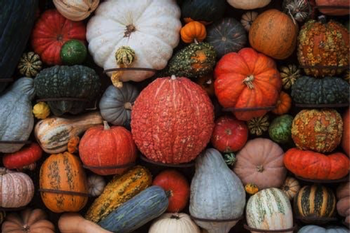Squash - Winter
-
Scientific NameCurcurbita pepo (acorn) and Cucurbita maxima (butternut)
-
General InformationWinter squash originated in the Americas and thrives in Marin's Mediterranean climate. Varieties include acorn, butternut, Hubbard, pumpkin, and spaghetti squash. Bush and vining varieties available. Requires little labor and stores well in fall and winter. Winter squash are full of fiber, beta carotene, vitamin, niacin, magnesium, calcium, and iron.
 Photo: Jacqueline Smith
Photo: Jacqueline Smith -
When to Plant
Plant seeds indoors beginning in March. Plant starts and or seeds outdoors mid-April to mid-June. For best results, wait until soil is warmed up in the spring and night temperatures are above 55 degrees.
-
Planting
Choose a sunny spot with at least six hours of full sun. Directly seed one inch deep in a four to six inch flat-topped mound, using three seeds per mound. When direct seeding or planting starts, irrigate beds deeply prior to planting. Keep beds moist during seed germination. When plants are three inches tall, thin to one plant per mound.
-
Soil Requirements
Does well in a range of soil types, but grows best in well-drained sandy loam with a pH of 5.8 to 6.5.
-
Water Requirements
Prior to planting, apply water to one foot depth to insure deep rooting. Keep soil moist when seeding. Replace water lost in top one to two inches of soil regularly. Even watering is key. Like tomatoes, squash is susceptible to blossom end rot caused by uneven watering and calcium deficiency.
-
Fertilizing
Squash prefer to grow in soil rich in organic matter, so add plenty of compost or composted manure before planting. If fertilizer is needed, use an organic vegetable fertilizer blend with a nutrient analysis of 10-10-5, 12-12-12, or similar. Follow directions on package.
-
Pollination
Not self-pollinating. Squash plants have male and female flowers on the same plant. Male pollen must be transferred to female flower for pollination to occur. Honeybees are the principal pollinators. Hand pollination is an option in areas with few honeybees.
-
Harvesting
You can expect a yield of about five winter squash per plant. Winter squash are ready to harvest when the rind hardens and the skin takes on a dull cast. Check the stem with a fingernail; if the skin can’t be dented, the squash is ready. When harvesting winter squash, use a knife and leave a two inch stem on the squash to help it last longer.
-
Storage
Store winter squash and pumpkins in a dry, fairly cool location (ideally 55 to 59ºF at 50 to 70% relative humidity). Under these conditions, if you harvest mature, not over-ripe fruit, you can expect a storage life of up to 60 days.
Curing is essential for the long storage of winter squash. Cure winter squash before storing them by cutting them from vine, then sun cure for five to seven days. Winter squashes that require curing include 'Blue Hubbard', 'Buttercup', 'Butternut', and 'Spaghetti'. Acorn squash should not be cured; curing acorn squash will reduce its storage life and quality.
Store winter squash in a cool, dry place at 50° to 55°F with a relative humidity of 50 to 70 percent—higher humidity can result in rot. Acorn varieties: fruit can be eaten when harvested and eating quality is best within one month of harvest. Delicata varieties may be eaten when harvested and will maintain quality for three months. Butternut and large Kabocha will store for two to three months. Hubbard will store for three to six months. Turban will store for three to six months.
-
Good Varieties for Marin
Best bet: 'Hubbard' varieties (‘Red Kuri’ ‘Blue Ballet’) ‘Sweet Meat’
Acorn varieties: 'Sweet Reba' 'Table Queen' 'Carnival'
Delicata varieties: ‘Zeppelin’ ‘Sweet Dumpling’ ‘Cornell’s Bush’
Butternut varieties: ‘Waltham’ ‘Butterbush’ ‘JWS 6823’
Kabocha varieties: ‘Sunshine’ (bright orange-red) ‘Cha-Cha’ (dark green)
Turban varieties: 'Marina Di Chioggia' (sea pumpkin)
-
Helpful Tips
Hand pollination is an option in areas with few honeybees. Plant pollinator-friendly flowers nearby to encourage bees. Winter squash are usually vine forming. Make sure you have plenty of room (at least eight feet) for plant to expand. Try a bush variety if limited in space. Bush varieties do not produce as many fruits.
-
Common Problems
Powdery mildew – causes include plants spaced too close together and overhead watering.
Misshapen fruit and poor yield - cause is few honeybees are present and only partial pollination occurs. Hand pollination of female flowers with pollen from male flowers will increase yield.
Spacing problems – choose a bush type; contain the plant by pinching out the growing tips after a vine has set a few fruits.
-
Pests- Diseases & More
Spotted cucumber beetle, squash bug, powdery mildew

